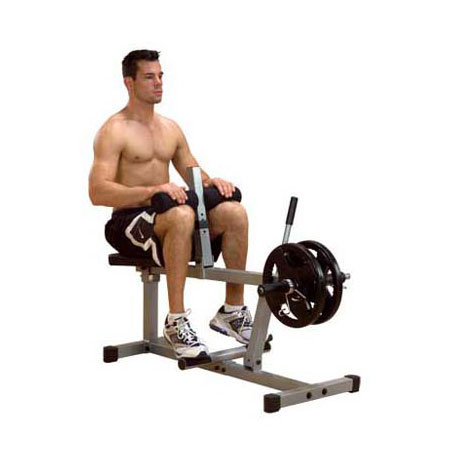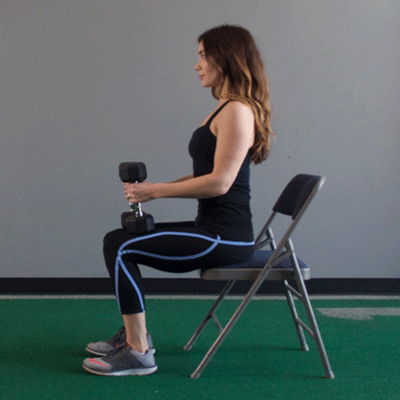
What are seated calf raises?
The seated calf raise is a resistance exercise that targets the calf muscles in the lower leg. It is usually performed on a seated calf machine but can be improvised with a dumbbell bench, foot block, and heavy dumbbells.
In this article, we will take an extensive look into the muscles activated with a seated calf raise, how to perform the exercise, the benefits of adding it to your routine and alternative movement options.
Which muscles are targeted with a seated calf raise?

The calves are made up of two muscles, the Gastrocnemius, and the Soleus. While the Soleus muscles will be activated with seated calf raises, the main target for growth will be the Gastrocnemius.
This muscle has two predominant heads and is responsible for pointing toes and flexing the knee for forward propulsion.
The calf muscle is constantly activated throughout the day as you walk, climb stairs, or even just stand. Using a seated calf raise machine will make the muscle flex through a larger than normal range of motion.
The stretch at the bottom of the movement and contraction at the top will break down fibres that are not used in day-to-day use and allow for growth.
What are the benefits of adding seated calf raises to my routine?
Regarding calves, you will find that there are a lot of differing opinions on whether they can be developed through resistance training like other muscles in the body.
They are in constant use in your daily life, so some will argue that what is the point of wasting time in the gym trying to exhaust them further. Others will state that calf size is purely dictated by genetics and that training them is a pointless exercise.
There is some truth to both of these arguments. Calf muscles are constantly worked throughout the day, making them well-developed muscles before you even start training them. Experienced trainers will usually agree with this, but there is still room for 20%-25% growth by pushing the muscle beyond its normal limits.
Genetics will not stop your calves from growing but may limit how big they can get. Some people hardly ever train calves and have lower leg boulders, while others train them religiously without the same result.
There are some major advantages of having well-developed calves.
- A strong set of calf muscles will give you stability in your knees and ankles. This is essential for strength training as they are under a heavy load when deadlifting or squatting. It is also essential for day-to-day life as it gives you extra stability and balance.
- Weak calves are the factor behind a lot of knee injuries. This is especially true if you perform a lot of jumping exercises such as burpees or box jumps.
- Strong calves will make you a better sprinter and faster walker. You will have more explosive power in your legs, which can only be a good thing.
- Finally, there is the aesthetics! There is no point in having giant quads if they are supported by toothpicks. Also, the calves are always on show in the summer!
How do I perform seated calf raises?
Ideally, you will have access to a seated calf raise machine, but, if not, there are ways to work around it. We will go through some of the methods of performing seated calf raises below as well as alternative exercises for developing giant calves.
Seated calf raises on calf raise machine.
Firstly, load the desired weight plates onto the front of the machine or, if you have a cable machine, select your weight from the stack.
If you have never used this apparatus before, start with a low weight and work your way up to find your working set weight. This is not a machine to go heavy on unless you know what you are doing as there is a real risk of injury.
Most seated calf raise machines will have adjustable thigh pads and a safety handle. Make sure that you follow the instructions on the side of the machine as they do differ.
How to do a seated calf raise with dumbbells.
Seated calf raises can also be performed with dumbbells. The movement is the same as with using a machine, just a bit less convenient. You will need a bench, a block to rest your toes on, and a pair of dumbbells.
- Sit at the end of the bench with the balls of your feet on the block and dumbbells resting on the tops of your knees.
- Take a deep breath, upon exhaling, lift your heels off the floor by pressing your toes downwards.
- When the calf is fully contracted, hold the position and squeeze it for a few seconds.
- Slowly lower the heels back to the starting position so that the calf muscle is fully stretched.
- Repeat for the required number of sets and reps.
Form is everything with this exercise. Make sure that you are keeping a straight spine and that your calves are the only muscles activated throughout the movement.
Calf muscles react better to intensity rather than heavy weight, so go for a medium weight and focus on slow movement with short rest periods between sets.
Barbell seated calf raises.
The above exercises can be performed in the same way with a barbell. Set up as you would for dumbbell calf raises, but instead of using dumbbells, place a loaded barbell on your knees.
If you work your way up to a heavy weight, put a pad on the bar to stop it from rubbing on the tops of your knees.
How many reps of calf raises should I do?
Calf muscles respond better to intensity and strain than overload. Using a weight that is too heavy will not allow you to fully stretch and contract the calf in a meaningful way. Select a medium weight and aim for 15+ reps per set. Keep the rest periods short (30-45 seconds) and shoot for 5-6 sets.



